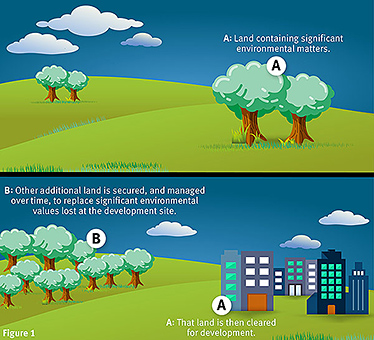An impact site assessment tool is available to assist you in identifying the full extent of all significant residual impacts on prescribed environmental matters contained on an impact site. You can request to have the impact site assessment results emailed to you. The email generates a report and spreadsheet (in an attached csv file) of the impact site assessment results. This tool is not mandatory, however, applicants are encouraged to use the tool and submit the csv file results with their relevant development application.
What is an environmental offset and when is it required?
An environmental offset compensates for unavoidable impacts on significant environmental matters, (e.g. valuable species and ecosystems) on one site, by securing land at another site, and managing that land over a period of time, to replace those significant environmental matters which were lost.
Figure 1 provides a simple illustration of the basic concept of providing an environmental offset. Figure 1 illustrates land containing environmental values at one site being cleared for development. Those environmental values are then replaced by providing an environmental offset at another site, which contains those same environmental values which were impacted as a result of the development.


Under the Environmental Offsets Act 2014 an environmental offset is defined as an activity undertaken to counterbalance a significant residual impact of a prescribed activity on a prescribed environmental matter.
The Environmental Offsets Act 2014 also states that an environmental offset must achieve a conservation outcome for the impacted prescribed environmental matter. A conservation outcome is achieved by an environmental offset if the offset is selected, designed, and managed to maintain the viability of the prescribed environmental matter. That is, to maintain the status quo of the prescribed environmental matter as if the development and environmental offset had not occurred.
When is an environmental offset required?
An environmental offset may be required as a condition of approval where—following consideration of avoidance and mitigation measures—a prescribed activity is likely to result in a significant residual impact on a prescribed environmental matter(s). Figure 2 provides an overview of the process used to determine if an environmental offset is required for an activity.
A list of prescribed activities are identified in Schedule 1 of the Environmental Offsets Regulation 2014. A list of prescribed environmental matters are outlined in Schedule 2 of the Environmental Offsets Regulation 2014.
For further information about the identification and assessment of prescribed environmental matters, refer to the information sheet Resources for matters of state environmental significance.
For further information on the relationship between prescribed activities and prescribed environmental matters see section 3.3 of the General guide, which provides a summary of prescribed environmental matters that may be subject to an environmental offset requirement for each type of prescribed activity.

Significant residual impacts
The Significant Residual Impact Guideline (PDF, 557KB) is used for consideration of all potential offset requirements for Matters of State Environmental Significance, for applications made under the Environmental Protection Act 1994, Nature Conservation Act 1992 and Marine Parks Act 2004.
For applications made under the Planning Act 2016 or the repealed Sustainable Planning Act 2009, you may contact the Department of State Development, Infrastructure, Local Government and Planning for their significant residual impact guideline. Both Significant Residual Impact Guidelines are used to determine if a residual impact from a prescribed activity is significant.
The following tools and guide can assist you through this process:
The Landscape Fragmentation and Connectivity Tool enables a decision to be made on the significance of an impact on connectivity areas containing remnant vegetation Category B. The tool is available at the Queensland Spatial Catalogue (search for “offsets”) link.
The General guide is available to assist you in interpreting and implementing the Queensland environmental offsets framework. This is a non-statutory document, and it provides an explanation of each step in determining if an environmental offset is required, and guidance on how to deliver an environmental offset requirement.
Advanced offsets
An advanced offset is an area of land that has been identified and registered by the Queensland Government for potential use as an environmental offset in the future because it contains, or is capable of containing, one or more Matters of State Environmental Significance (MSES).
Advanced offsets may be used in the future as an environmental offset to compensate for a future significant residual impact on one or more prescribed environmental matters. Advanced offsets provide a means to better manage the risks associated with:
- the time delay in finding suitable sites for environmental offsets
- the delivery of conservation outcomes for the prescribed environmental matters occurring on the site.
Learn more about advanced offsets and its application to both landholders and proponents.
Environmental offset projects
The Offsets Project Management Committee has supported 17 environmental offsets projects that include multiple environmental conservation outcomes.
The Austral toadflax financial offset project is an example of an environmental offset that utilises funds from the Queensland Government’s Environmental Offset Account to compensate for impacts to a local population of Austral toadflax (Thesium australe).
The Offset project for the ground parrot is another example of an environmental offset that is resorting habitat for the ground parrot (Pezoporus wallicus wallicus), compensating for the removal of habitat from the expansion of the Sunshine Coast Airport runway.
Find out about the current environmental offsets projects being undertaken and the associated environmental outcomes.


